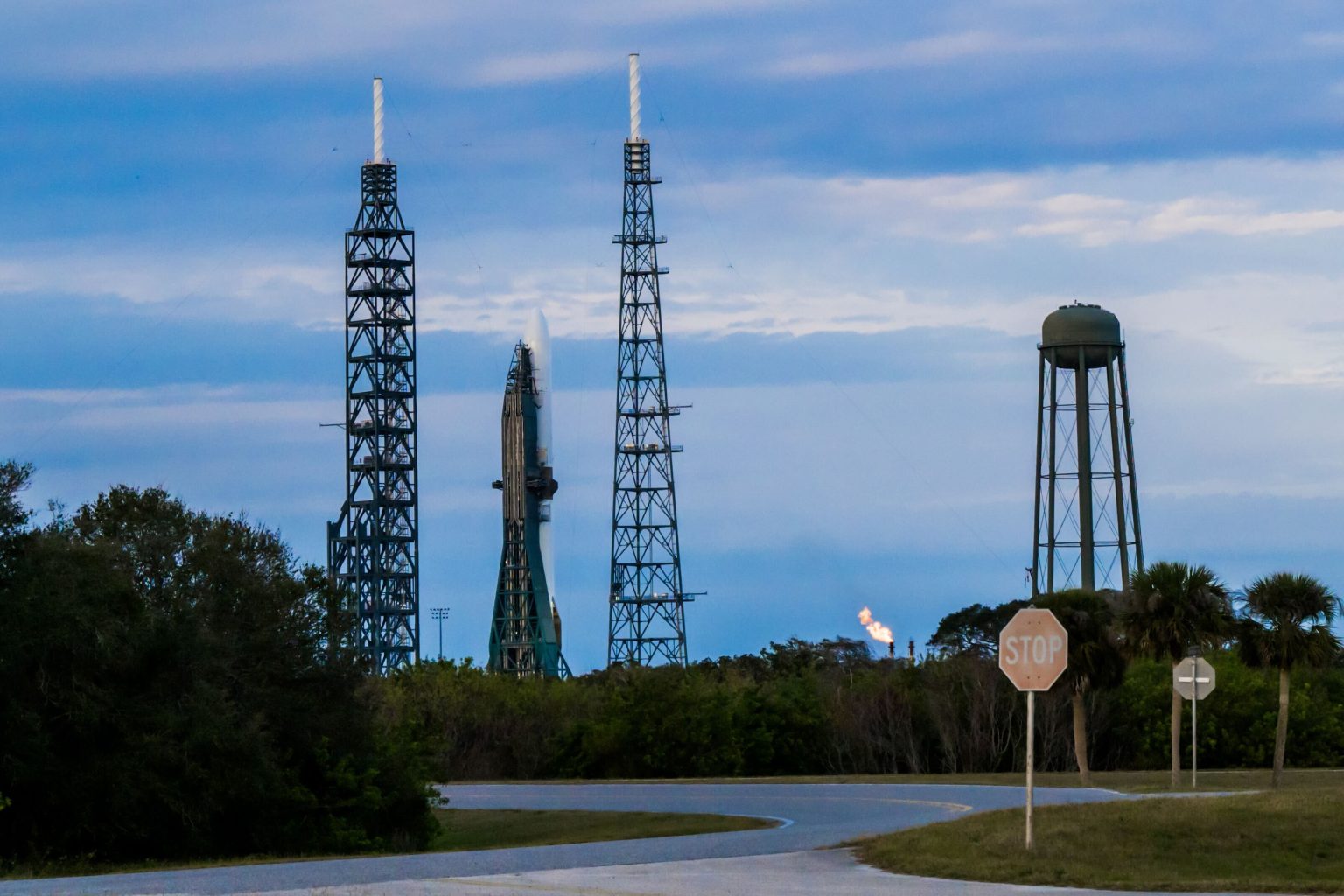Summarize this content to 2000 words in 6 paragraphs
Blue Origin’s New Glenn rocket stands on its Florida launch pad. (GeekWire Photo / Kevin Lisota)
Over the course of just a few hours today, Jeff Bezos’ Blue Origin space venture made two adjustments to the schedule for launching its heavy-lift New Glenn rocket to orbit for the first time.
At first, Blue Origin said it was planning to attempt liftoff from Cape Canaveral Space Force Station’s Launch Complex 36 tonight, during a three-hour launch window beginning at 1 a.m. ET Tuesday (10 p.m. PT Monday). But less than two and a half hours later, the company pushed back the launch date to the same time frame early Thursday ET (late Wednesday PT).
No reason was immediately given for the quick change, but in today’s first announcement, Blue Origin acknowledged that a “poor weather forecast at LC-36 could result in missing” tonight’s launch window.
The schedule shifts came after Blue Origin aborted its first honest-to-goodness orbital launch attempt early today. Blue Origin said the launch was scrubbed “due to ice forming in a purge line on an auxiliary power unit that powers some of our hydraulic systems.” In the days before that scrub, Blue Origin delayed New Glenn’s launch twice because of rough seas in an area of the Atlantic Ocean where a barge has been stationed for a booster landing attempt.
Weather conditions at the launch pad are expected to improve after tonight, but conditions in the landing zone may not be as good, according to the Space Force. Blue Origin is expected to stream coverage of the countdown via its website, starting about an hour before the projected launch time.
For Blue Origin, there’s a lot riding on New Glenn’s mission, known as NG-1. Although the company has launched smaller New Shepard rockets on suborbital spaceflights for a decade, it has never put a payload into Earth orbit. That would change with a successful New Glenn launch.
The primary objective for NG-1 is to put a payload into orbit to test telemetry, communications and control systems for Blue Ring, a multi-mission space mobility vehicle that Blue Origin is developing.
If New Glenn meets with success, that would mean more competition for Elon Musk’s SpaceX, which currently dominates the orbital launch industry. It would also open the way for a host of applications that Blue Origin aims to support — ranging from satellite constellations to moon missions to a commercial space station.
“We need to lower the cost of access to space … and that’s what New Glenn, our orbital vehicle, is all about,” Bezos said at the DealBook Summit in December.
Blue Origin founder Jeff Bezos and CEO Dave Limp monitor the first countdown to the New Glenn rocket’s launch from Mission Control early on Jan. 13. (Blue Origin via YouTube)
New Glenn’s origin story goes back to 2012. Three years into the design and development effort, Bezos made a splash when he announced that the orbital-class rocket, named after pioneering NASA astronaut John Glenn, would be built at a 750,000-square-foot Florida factory and launched from Cape Canaveral.
The rocket stands more than 320 feet (98 meters) high and features a 7-meter (23-foot-wide) payload fairing, which Blue Origin says can provide twice the volume of a standard 5-meter fairing. An entire New Shepard rocket could fit within the fairing, with room to spare on the sides.
New Glenn’s first stage is powered by seven of Blue Origin’s BE-4 engines, fueled with liquefied natural gas. The second stage makes use of two hydrogen-fueled BE-3U engines. Maximum thrust at liftoff is 3.8 million pounds, which is about half the thrust that was generated by the Saturn V moon rockets of the Apollo era. The rocket should be able to put up to 99,000 pounds of payload into low Earth orbit, which is 50 percent more than NASA’s space shuttle could carry.
The road to space hasn’t always run smooth. For example, Blue Origin had to overcome problems that were encountered during development of New Glenn’s BE-4 rocket engines. Success is by no means guaranteed.
New Glenn’s primary payload is Blue Ring Pathfinder, which will demonstrate the technologies that Blue Origin is incorporating in its Blue Ring vehicle. The development effort is supported by a Defense Innovation Unit program aimed at facilitating greater in-space mobility for the Pentagon. NG-1 will also serve as Blue Origin’s first certification flight for the National Security Space Launch program.
The rocket’s second stage is slated to send the payload into a highly elliptical orbit that ranges from 1,490 to 12,000 miles (2,400 to 19,300 kilometers) in altitude. That orbit is meant to test the capabilities of the in-space system at those heights.
The first-stage booster is designed to fly itself to an at-sea landing, hundreds of miles offshore, on a custom-built barge that’s been christened Jacklyn as a tribute to Jeff Bezos’ mother.
Blue Origin CEO Dave Limp emphasized that the test mission’s success won’t depend on whether or not the booster sticks the landing. “Our objective is to reach orbit. Anything beyond that is a bonus,” Limp said in posting to X. “Landing our booster offshore is ambitious — but we’re going for it. No matter what, we will learn a lot.”
The “no-matter-what” sentiment is reflected in the nickname that’s been given to the booster: “So You’re Telling Me There’s a Chance.”
Blue Origin says it has several New Glenn vehicles in production at its Florida factory, and has filled out a “full customer manifest” for the months ahead.
High-profile missions include satellite launches to low Earth orbit for Amazon’s Project Kuiper broadband constellation and for AST SpaceMobile’s space-based cellular network. Looking farther out, New Glenn is due to launch twin orbiters to Mars for NASA’s ESCAPADE mission.


